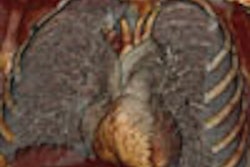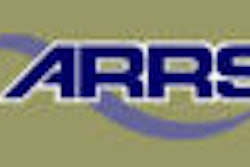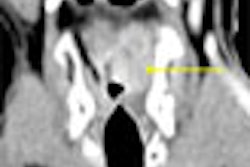CHICAGO - Cardiac imaging may have slipped away from radiology in stages over the years, but radiologists can capture the boom in coronary CT angiography if they move fast, train hard, and plan to use at least a 64-slice scanner.
Those were some of the views shared by leading practitioners during a lively and opinionated keynote and panel discussion Tuesday at the RSNA meeting.
The special cardiac integrated science and practice (ISP) session also featured multiple studies suggesting that, yes, 64-slice scanning is indeed better than 16-slice for evaluating the coronary arteries.
Leading off the session was a combination overview and call-to-arms from keynote speaker Dr. George Hartnell, chief of cardiovascular and interventional radiology at Baystate Medical Center in Springfield, MA.
Hartnell reminded the audience of how much cardiac imaging has moved from the domain of radiologists to cardiologists -- echocardiography, conventional angiography, nuclear -- and stressed that now is the time for individual radiologists to decide whether they are going to do cardiac CT and MR.
The decision is critical, he said, because the commitment is substantial. Radiologists will need to master material that may be defined by cardiologists, who have already established guidelines for performance of cardiac CT and MR.
And because image quality is key, Hartnell said, "Train your techs well, otherwise your life is going to be hell."
So given the training involved, can radiologists in smaller groups really do cardiac CT and MR, asked one audience member.
"I'm optimistic that it can be done," said Dr. Martin Lipton, now the director of education in noninvasive cardiovascular imaging at Brigham and Women's Hospital in Boston.
"This is not like doing a coronary arteriogram," stated Lipton, who said he performed 7,000 of those in his past. "I can tell you people with whom I work, who haven't seen too many coronary arteriograms in radiology, pick up this CT work very quickly."
And, asked another radiologist from the audience, if the time to start a cardiac imaging service is now, should we go ahead and do that with our current 16-slice scanner?
An emphatically shouted "No!" came from the back of the room and prompted laughter from the audience but agreement from the panel.
"Not only would you probably need a 64-slice scanner, but in June of next year you'll probably realize you need a double 64 or a 256," said panelist Dr. Andre Duerinckx, who now does cardiac imaging research in Winston-Salem, NC.
What about 24/7 service? Do we have to offer that if we're going to do the cross-sectional coronary imaging in our community, asked another audience member.
No, the panelists agreed -- nor should nighthawk providers be expected to cover such reads given the much longer time required to read a coronary CTA. Instead, those high-risk patients who arrive in the middle of the night should go straight to the cath lab, and lower-risk patients can wait.
"Our cardiologists say there is no such animal as an emergency cardiac CT," said Dr. Tamar Gaspar of Carmel Medical Center in Haifa, Israel, who presented data on her institution's successful use of 64-slice CT to safely discharge patients presenting to the emergency room with chest pain.
And once you've got the 64-slice scanner, you might try to get your center on TV host Oprah Winfrey's Web site list of facilities with such scanners, suggested Hartnell.
By Tracie L. Thompson
AuntMinnie.com staff writer
November 30, 2005
Related Reading
Cardiology societies adopt cardiac CT, MR standards, August 2, 2005
Copyright © 2005 AuntMinnie.com



















